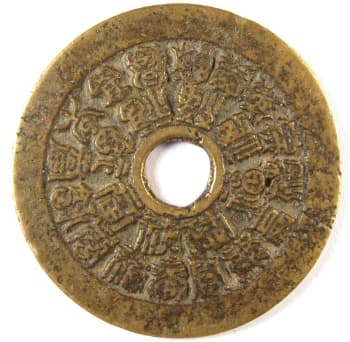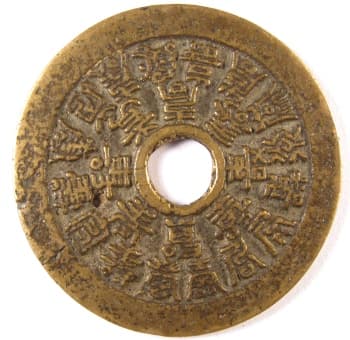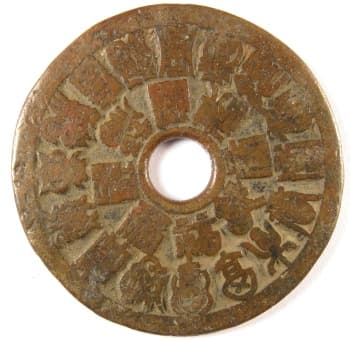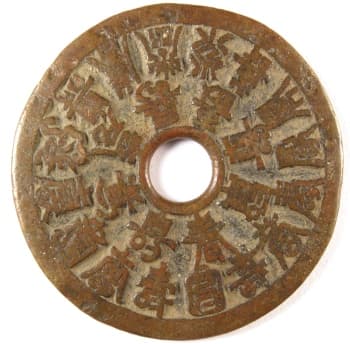
"Good Fortune" and Longevity Charms

Charms with 24 "Good Fortune" Characters and 24 Longevity Characters
The most common Chinese character (symbol) seen on charms is fu (福) which means "good fortune" and happiness. The second most common Chinese character (symbol) appearing on charms is shou (寿) meaning "long life" or longevity.Each of the old Chinese charms displayed below has 24 different variations of the "good fortune" character fu written on one side and 24 different variations of the longevity character shou written on the other side.
Reasons for 24 Characters (Symbols)
Apparently, more characters bring more "good luck" but why 24?
It is interesting that this particular type of old Chinese charm always has 24 characters (symbols) on a side. I have done some research but so far have not been able to determine from any source as to exactly why the number of characters is always 24.
Possible reasons are proposed below.
Twenty-four is a multiple of 8. Eight is considered a very auspicious number in Chinese because of the similar pronunciation in certain Chinese dialects of the number "8" and the Chinese for wealth or "good fortune".
The reason may be because 24 is the sum of the number of zodiac animals (12) and the number of Earthly Branches (12) displayed on old Chinese zodiac charms. (For additional information, please see ancient Chinese zodiac charms.)
The special Chinese compass (luo pan 罗盘) used in feng shui (风水) has a ring which indicates 24 directions poetically referred to as "mountains" (shan 山) each 15 degrees apart. The 24 "mountains" include 4 of the 8 trigrams which are used as intercardinal (corner points), 8 of the 10 Heavenly Stems (excluding the two Earth Stems), and the 12 Earthly Branches.
The number 24 is also the sum of the 12 months of the year and the 12 shichen (时辰). In ancient China, the day was divided into 12 two-hour periods which were called shichen.
Perhaps the reason is because the Chinese, since ancient times, have divided the year into 24 seasonal markers or solar terms or nodes called jieqi (节气). The 24 jieqi correspond to the different positions the sun occupies in regard to the 12 signs of the zodiac and include the following: Slight cold, Great cold, Beginning of Spring, Rain water, Excited insects, Vernal equinox, Pure brightness, Corn rain, Beginning of Summer, Small fullness, Sprouting seeds, Summer solstice, Slight heat, Great heat, Beginning of Autumn, Stopping of heat, White dew, Autumnal equinox, Cold dew, Frost's descent, Beginning of Winter, Slight snow, Heavy snow, and Winter solstice.
Confucianism dominated Chinese society for two thousand years and included as its primary virtue "filial piety" which was respect for one's parents and ancestors. One of the most famous historical collections of stories concerning how children displayed filial piety, and known by all Chinese, was "The Twenty-Four Examples of Filial Piety" (ershisixiao 二十四孝). (For a very interesting discussion of a Confucian charm depicting four of these stories please visit Confucian Charms.)
The first religious Daoist sect, known as Wudoumi Dao (五 斗米道 "Five Bushels of Rice"), was established by Zhang Daoling at the end of the Han Dynasty and organized into 24 districts or dioceses (zhi 治).
Finally, the reason for 24 characters may be associated with the Chinese traditionally viewing life in groups of 12. For example, a child grew into adolescence at the age of 12. A person entered society for the first time at age 24. At 36, a person reached maturity. At 48, a person was expected to have accomplished something in life and then to retire at age 60.
Whatever the real reason may be for having exactly 24 fu characters and 24 shou characters, anyone who appreciates the beauty of Chinese calligraphy will certainly enjoy viewing these charms.

This old Chinese charm has the "good fortune" character fu (福) written 24 times on one side.
Each character is written in a slightly different way or style.
You will also notice that this type of charm has a circular hole instead of the square hole found on Chinese coins.
Most charms with round holes were meant to be worn on a necklace or hung from the waist.
The diameter of this piece is almost 45 mm and the weight is 21.9 grams.


